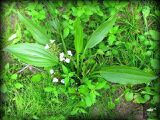Aquarius subulatus (Mart. ex Schult.f.) Christenh. & Byng

Basionym : Echinodorus subalatus (Mart. ex Schult.f.) Griseb.[1]
Synonyms:
Echinodorus andrieuxii (Hook. & Arn.) Small
Echinodorus andrieuxii var. longistylus (Buchenau) Rataj
Echinodorus ellipticus var. ovatus Micheli
Echinodorus intermedius (Mart. ex Schult.f.) Griseb.
Echinodorus subalatus subsp. andrieuxii (Hook. & Arn.) R.R.Haynes & Holm-Niels.
Echinodorus subalatus var. minor F.J.Mey.
Alisma andrieuxii Hook. & Arn.
Alisma subalatum var. majus Schult.f.
Alisma subalatum var. medium Schult.f.
Alisma subalatum var. minus Schult.f.
Sagittaria palifolia var. subalata (Mart. ex Schult.f.) Kuntze
Occurrence:
From Mexico to Bolivia and southern Brazil.
Ecology
Temporary ponds and damp depressions on flooded savannahs, floodplains. From sea level to 1500 m.
Morphology General habit
Perennial, from rhizomes, petioles and stems glabrous to rough, up to 120 cm, rhizomes up to 8 cm long, 4 cm diam. Leaves mostly emersed, leaf blade elliptic to oval, 5 - 9-veined, 15 - 40 cm long, 4 - 17 cm wide, glaucous markings absent or present as lines, apex acute, base finely attenuated, petioles canalized, furrowed, up to 50 cm long , 0.5 - 2 cm diam, base with sheath up to 15 cm long, submerged leaves linear-elliptic, entire, 3 - 5 veins, 7 - 15 cm long, 0.5 - 1 cm wide, apex acute, base attenuated, glaucous markings absent, petioles canalized, furrowed, up to 5 cm long, c. 0.3 mm diam., base with sheath up to 1.5 cm long
Morphology Reproductive morphology Fruits
Fruit oblanceoloid, 3 - 6-ribbed, glandular, 1.5 - 2.3 mm long, 1 mm wide, glands 1 (- 3), circular, separated by ribs, beak end, erect, 0.5 - 1.5 mm.
Morphology Reproductive morphology Inflorescences
Inflorescence racemose or rarely paniculate, of 5 - 15 whorls, each 3 - 18-flowered, erect, shorter than or slightly exceeding leaves, occasionally multiplying, up to 40 cm long, 2 - 8 cm wide, rachis triangular in cross-section, alate , petioles furrowed, up to 50 cm long, bracts fused, lanceolate, much longer than petioles subtended, 1.5 - 6 cm long, 2 - 9 mm wide, 11 - 19-veined, apex long-pointed, pedicels spreading in flower and fruit, 0.2 - 1.5 cm long, approx. 0.5 mm diam. flowers 1.5 - 3 cm in diameter, sepals and petals spreading, sepals 9 - 15-veined, ca. 5 mm long, ca. 4 mm wide, veins without papillae, petals not clawed, not overlapping, ca. 9 mm long, ca. 6 mm wide, stamens 12, anthers many-sided, ca. 1.2 mm long, filaments ca. 1.8 mm long, carpels numerous
Phenology
Flowering and fruiting all year round. [1]
-
Echinodorus subalatus (Mart.) Griseb.[2]
-
Echinodorus subalatus (Mart.) Griseb.[2]
-
Echinodorus subalatus (Mart.) Griseb.[2]
-
Echinodorus subalatus (Mart.) Griseb.[3]
-
Echinodorus subalatus (Mart.) Griseb.[4]
- ↑ 1.0 1.1 POWO (2021). "Plants of the World Online. Facilitated by the Royal Botanic Gardens, Kew. Im Internet veröffentlicht; http://www.plantsoftheworldonline.org/ Abgerufen am 22. August 2021."
- ↑ 2.0 2.1 2.2 Kostiantyn Loboda, Black Water http://echinodorus.com.ua/
- ↑ Echinodorus subalatus (Mart. ex Schult.f.) Griseb. Observed in Brazil by Breno Figueiredo (licensed under http://creativecommons.org/licenses/by-nc/4.0/)
- ↑ Digital Image © Board of Trustees, RBG Kew http://creativecommons.org/licenses/by/3.0/





